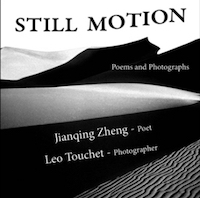
|
||
|
|
|
| Issue 29: | August 2025 |
| Book Review: | 691 words |
By Ce Rosenow
Still Motion: Poems and Photographs
By Jianqing Zheng and Leo Touchet
Photo Circle Press
Release date: 1 January 2025
ISBN: 978-1-7324433-9-6
8.5 x 8.5 inches // 62 pages
| Still Motion is an exciting collaboration between two talented artists, Leo Touchet and Jianqing Zheng. The collection presents Touchet’s black and white photographs and Zheng’s ekphrastic poems on facing pages. Zheng selected the photos and then wrote his poems in response to them. He explains his approach to ekphrasis in a note at the beginning of the book: |  Photo Circle Press 1 January 2025 |
“Ekphrastic writing is not a retelling of what we see in artworks; it concerns an interaction of the senses, a creation from the original art” (6). This perspective results in a series of fine poems that explore and appreciate the various subjects of photographs ranging from haunting portraits to arresting street scenes to vast landscapes.
Touchet’s photos use various approaches. Some focus intently on people while also creating a deeper understanding of the surrounding scene. For instance, in Annual JazzFest in the French Quarter, New Orleans, Louisiana 1969, he captures the split second before a young man pops the top on a Coca-Cola® bottle by leveraging it against a horizontal rung. The man’s blurred hand is in motion and his expression suggests that he is entirely immersed in his action. One feels the heat and humidity as well as the anticipation of refreshment in this single moment. In other images, such as the many photographs of dunes, Touchet captures shapes, light, and shadows in ways that make the landscapes look like works of abstract art.
Zheng’s poems engage the photographs through content, formal choices, and visual presentation on the page. Drawing on specific details from the images, Zheng sometimes develops a narrative about the scene, imagining what is taking place. In other instances, he shares a story of his own that connects to aspects of the photo. In crafting the poems, he makes decisions about how to reflect elements of the photo formally while also supporting the story he develops. For example, in “Reversal,” he responds to Touchet’s photograph Musicians in a Jazz Funeral Processional, which depicts two trombonists moving toward the camera, followed by drummers and other musicians. Zheng’s poem uses onomatopoeia and alliteration to describe the “whining / clarinet and drums” with their “beat bebop boom” so that the music of the processional comes through in the auditory imagery.
The visual design of each poem often resonates with the visual elements in the photos. Zheng’s poem “Jazz Pop” offers a good example. It pairs with the photo Annual JazzFest in the French Quarter, New Orleans, Louisiana 1969 discussed previously in which a young man is about to open a bottle of Coke®. Zheng points out that the poem “is a shape poem using the form to suggest the shape of the Coke bottle in Leo’s JazzFest photograph” (6). “Sandscape,” on the other hand, responds to a landscape image. It uses undulating lines moving progressively farther to the right before pulling back slightly line by line to the left margin and then moving right again. The lines mimic the rolling sands in Touchet’s photo Mesquite Flats Sand Dunes, Death Valley National Park, California 1994. The haibun “Oneironaut” provides one final example. Haibun is a Japanese form that combines prose and haiku. In this poem, Zheng chooses to use a monoku or one-line haiku to follow the prose. The haiku, “field song row after row of sugarcanes,” visually mirrors both its own subject matter and the furrowed rows in Touchet’s photo on the opposite page, Sugar Cane Field after Harvest, Vermillion Parish, Louisiana 1991.
The visual movement of Zheng’s poems alongside that within Touchet’s photographs is initially signaled by the book’s title, Still Motion, and the upward movement of the letters in “Motion” on the cover. The photographs present moments of arrested motion while gesturing toward the action occurring before and after each photo is taken. When combined with poems of vitality and movement, these pairings offer layered meanings between the photos and poems. This collection is a wonderful project that provides inspiring examples of ekphrastic poems in dialogue with powerful photographs.
Ce Rosenow
is a writer, haiku poet and scholar, and educator who resides in Oregon. Her articles, essays, book reviews, and haiku and related forms are published widely in journals and anthologies in the USA and abroad. She is the author most recently of Lenard D. Moore and African American Haiku: Merging Traditions (Lexington Books, 2022).
She is co-author with Maurice Hamington of Care Ethics and Poetry (Palgrave/MacMillan, 2019), which addresses the relationship between poetry and feminist care ethics; one of four authors in The Color of Water edited by Carolyn Hall (Two Autumns Press, 2013); and one of eight authors in Beyond Within: A Collection of Rengay edited by Cherie Hunter Day (Sundog Press, 1997). Rosenow co-edited with Bob Arnold The Next One Thousand Years: The Selected Poems of Cid Corman (Longhouse Publishers, 2008).
The former president of the Haiku Society of America, Rosenow is Senior Editor for The Haiku Foundation’s JUXTA journal, Juxtapositions: Research and Scholarship in Haiku. She is also the former co-editor of Northwest Literary Forum and Portlandia Review of Books.
Author’s ePortfolio: https://rosenowce.wordpress.com/
| Copyright © 2019-2025 by MacQueen’s Quinterly and by those whose works appear here. | |
| Logo and website designed and built by Clare MacQueen; copyrighted © 2019-2025. | |
|
Data collection, storage, assimilation, or interpretation of this publication, in whole or in part, for the purpose of AI training are expressly forbidden, no exceptions. |
At MacQ, we take your privacy seriously. We do not collect, sell, rent, or exchange your name and email address, or any other information about you, to third parties for marketing purposes. When you contact us, we will use your name and email address only in order to respond to your questions, comments, etc.